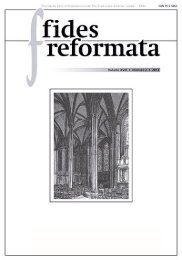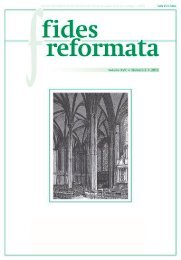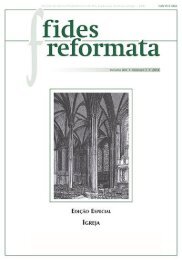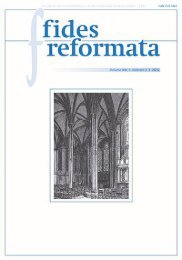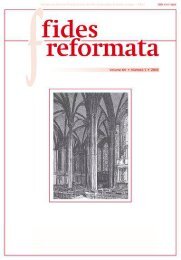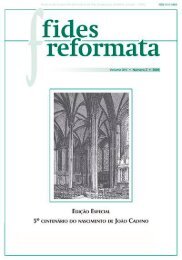You also want an ePaper? Increase the reach of your titles
YUMPU automatically turns print PDFs into web optimized ePapers that Google loves.
FIDES REFORMATA XIX, Nº 2 (2014): 95-115<br />
In his commentary about the passage of John 1:14, Herman Ridderbos<br />
deems the link with the transfiguration to be unlikely; at the same time he<br />
<strong>do</strong>es refer to Luke 9 and 2 Peter 1. 22 B.F. Westcott makes only a mere textual<br />
reference to Luke 9 without drawing the conclusion that, in the prologue of<br />
John, an allusion is possibly made to the transfiguration. 23<br />
In the introduction to his commentary on John, C.K. Barrett has pointed<br />
out that John did not mistakenly leave out important synoptic passages. This<br />
observation could explain the absence of the transfiguration in the Fourth Gospel.<br />
Barrett writes: “John safeguards their meaning by stripping them of their<br />
historical individuality and building them into the theological framework of<br />
his gospel”. 24 This means that the evangelist subsumed the transfiguration in his<br />
prologue, and by <strong>do</strong>ing so he used it as thematic principle for his entire gospel.<br />
As an alternative for the transfiguration John records a heavenly voice in<br />
chapter 12, which we <strong>do</strong> not find in the Synoptic Gospels. His passage starts<br />
with the request from Greeks whether they could see Jesus, or rather meet him<br />
(12:21: θέλομεν τὸν Ἰησοῦν ἰδεῖν). During that meeting Jesus calls upon his<br />
heavenly Father: “Father, glorify your name!” (πάτερ, δόξασόν σου τὸ ὄνομα).<br />
Then a voice came from heaven: “I have glorified it and will glorify it again”<br />
(Καὶ ἐδόξασα καὶ πάλιν δοξάσω (verse 28); also see 8:54 and 17:4-8, to be<br />
considered as a commentary on this glorification). That voice sounded in the<br />
presence of a large crowd of people; ὁ ὄχλος is the subject of this entire chapter.<br />
“The crowd that was there and heard it said…” (verse 29: ὁ οὖν ὄχλος ὁ ἑστὼς<br />
καὶ ἀκούσας), represents a collective reaction: Greeks, disciples, bystanders<br />
(Jews). Unlike the transfiguration, where only three disciples were present, this<br />
glorification of Jesus happened in public. It is an ‘international’ signal, intended<br />
to show that the king<strong>do</strong>m of God will be opened for Jews and non-Jews alike. 25<br />
In conclusion, where Jesus who is the incarnate Word appears, divine<br />
glory is made audible and visible. Now, John together with the other eyewitnesses<br />
says: we were privileged to behold that divine glory. This means that<br />
all readers of the Fourth Gospel are assured that John, as the last surviving<br />
apostle, represents a group of eyewitnesses who are in a position to confirm<br />
and support his testimony.<br />
22 RIDDERBOS, Herman. Het evangelie naar Johannes: proeve van een theologische exegese,<br />
v. 1. Kampen: Kok, <strong>19</strong>87, p. 69.<br />
23 WESTCOTT, B.F. The Gospel according to St. John: The Authorized Version with Introduction<br />
and Notes. Reprinted. Grand Rapids: Eerdmans, <strong>19</strong>75, p. 12.<br />
24 BARRETT, C.K. The Gospel according to St John. An Introduction with Commentary and<br />
Notes on the Greek Text. Lon<strong>do</strong>n: SPCK, <strong>19</strong>55, p. 42 in the first edition; somewhat shorter in the second<br />
edition (<strong>19</strong>78), 53.<br />
25 KIM, Byun-Gook. The Voice from Heaven in the Gospel of John. Meaning and Function of<br />
John 12:20-36. Kampen: Mondiss, <strong>19</strong>98, p. 84-86, 94.<br />
103






